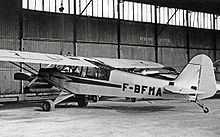Piper PA-11
| PA-11 | |
|---|---|
| | |
| Role | Personal use aircraft |
| National origin | USA |
| Manufacturer | Piper Aircraft |
| First flight | August 1946 |
| Introduction | 1947 |
| Status | still in operation |
| Primary user | private pilot owners |
| Produced | 1947-1949 |
| Number built | 1,541[1] |
| Developed from | Piper J-3 Cub |
| Variants | Piper PA-18 Super Cub |
The Piper PA-11 Cub Special is a later production, two-place variant of the Piper J-3 Cub light propeller-driven aircraft, manufactured by Piper Aircraft.
Design and development

The airframe is basically the same as a J-3, but the engine mount is angled slightly lower, the windshield more sloped, the cowling is fully closed and the fuel tank was raised and placed in the port wing.[2] Both seats were slightly moved back, and solo flying was usually from the front seat. Early PA-11s had a Continental A65-8 engine, while the later ones had the option of a Continental C90-8.[2]
Several current-production light-sport aircraft are being produced based on this configuration. On the early PA-11s, the fuselage was painted with a metallic blue on the lower half the rest being Lock Haven Yellow. The later PA-11s were all yellow with a simple brown stripe.

The aircraft formed the basis for the next evolution in the Piper Cub series: The Piper PA-18 Super Cub. The PA-11 and its successor, the PA-18-95, share many common traits. With a gross weight of 1,220 lb (553 kg). and average empty weight of 850 lb (386 kg)., the PA-11 is a light enough to perform well, yet heavy enough to maneuver easily in more wind than the lighter J-3 Cub. The PA-11 is capable of short takeoffs and landings, yet has a respectable cruise speed for its configuration. Given that the PA-11 falls into the modern day category of light sport aircraft it is a popular airplane to acquire and commands a premium price.
Modifications

The PA-11 was one of the first aircraft to be used in experiments with the nose-wheel (also known as tricycle gear) configuration. Although its original design is intended to be a tail-dragger, a modification was created to mount a nosewheel onto the front of the aircraft. The nose-wheel is attached to the two rear engine mounts by y-shaped steel tubes attached to a steel tube with a shaft that slides freely with the wheel. Cables ran underneath the belly directly from fixtures on the rudder pedals to the nosewheel shaft. This gave the ability to steer by pivoting the nosewheel shaft with the rudder pedals. The shock system consisted of six circular bungee cords, sometimes four for softer landings, located on either side of the nosewheel shaft to ears on the top tube and the bottom shaft connected to the wheel. In order for the aircraft to balance properly with the nosewheel, the main gear was flipped around so that the center of balance would move forward. The pilot would sit in the front seat for added balance.
Most PA-11s in service today retain the original tailwheel undercarriage layout.[3] Numbers of Cub Specials have been converted for flight operation using floats.
Variants
- Piper PA-11 Cub Special
- Two-seat light aircraft, powered by a 65 hp (48 kW) Continental A65-8 piston engine.
- L-18B
- Military version of the PA-11 Cub Special, powered by a 95 hp (71 kW) Continental C90-8F piston engine. 105 built and delivered to Turkey, under the Military Assistance Program.
Operators
Military Operators
Specifications (PA-11 with 90 hp Continental engine)
Data from Piper Aircraft and Their Forerunners [4]
General characteristics
- Crew: 1
- Capacity: 1 passenger
- Payload: 470 lbs (213 kg)
- Length: 22 ft 4 in (6.8 m)
- Wingspan: 35 ft 2 in (10.7 m)
- Height: 6 ft 8 in (2.03 m)
- Empty weight: 750 lb (340 kg)
- Loaded weight: 1,220 lb (553 kg)
- Useful load: 470 lb (213 kg)
- Powerplant: × 1 Continental C90-8, 90 hp (67 kW) each
Performance
- Maximum speed: 112 mph (181 km/h)
- Cruise speed: 100 mph (162 km/h)
- Stall speed: 40 mph (65 km/h)
- Range: 350 miles (567 km)
- Service ceiling: 16,000 ft (4880 m)
References
- Notes
- Bibliography
- Peperell, Roger. Piper Aircraft and Their Forerunners. Tunbridge Wells, Kent, UK: Air-Britain (Historians) Ltd, 1987. ISBN 0-85130-149-5.
- Simpson, Rod. General Aviation Handbook. Leicester, UK: Midland Publishing, 2005. ISBN 1-85780-222-1 .
External links
![]() Media related to Piper PA-11 Cub Special at Wikimedia Commons
Media related to Piper PA-11 Cub Special at Wikimedia Commons
| ||||||||||
| ||||||||||||||||||||||||||||||||||||||
| ||||||||||||||||||||||